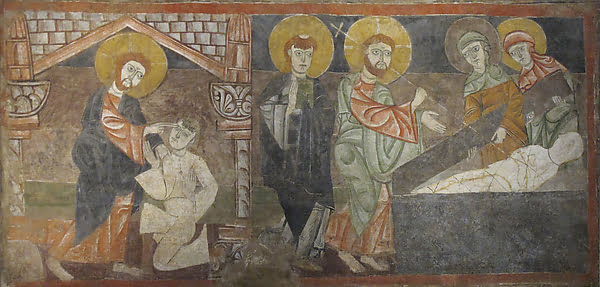Chapter Talk – Fourth Sunday of Lent – March 22, 2020, cycle-A
“Seeing with the inner eye” – This pithy phrase is how the Jesuit scripture scholar, Fr. John Donahue, begins his commentary on this Sunday’s gospel reading. One way I think we can express the focus of monastic life is to become more Christ-like in our seeing. And this means that we have to face the reality that we all are, to varying degrees, blind. The process of conversion involves purifying the eye of the heart so that we will see as God sees. Self-knowledge is important to help us see where we are partial, where we are not seeing the full reality inside ourselves and outside, in the situations of daily life. If we do not begin from the basis that I am blind, or, wonder, am I seeing the whole picture, or am I partial in my view, then, in the end, as the gospel will tell us, we are indeed blind!
These words of Hans Urs von Balthasar bring us to a humble awareness. He writes: “The Gospel’s long and dramatically told story of the healing of a man born blind culminates in the following alternatives: whoever recognizes that he owes his sight (his faith) to Christ, ultimately enters the light through the pure grace of the Lord; whoever thinks he sees and believes on his own account, without owing it to grace, is already blind and will ultimately be blind” (Light of the Word, p.58).
We are invited to view this gospel story as the unfolding of the blind man’s faith or the growth of faith…Faith enables us to see…faith connects us to Christ…it is our faith in the Christ life and the way of Christ that opens the heart to see: the truth of ourselves in any given moment, the truth of my sister or brother…and the truth that is God…Faith, von Balthasar implies, places us in the ambience of ‘grace’.
Conversion to a deepened faith: the eye of the heart continually needs this transformation…transformation into a living and growing faith. The darkness that opposes life lurks around every corner of our being. We are naïve not to anticipate this or to be aware of it. Every bit of murmuring that comes up in our hearts carries with it a cloud that blinds us to some degree…The emotion in the murmuring clouds the eye of the heart…and its result is that the heart becomes hardened or reactionary, and then, we are unable to view situations from a clear and wider horizon. More specifically, the outcome is that the small still voice of the Spirit is shut down because the ego energy of defending or being right is so strong. This is a hard pattern for all of us to change. We see its power to control in the Pharisees conversation with the man born blind, who now sees. They say to him: “You were born totally in sin, and you are trying to teach us.” The Pharisees’ comments reflect their inflation with what they ‘know’, as well as their refusal to witness something new, their refusal to receive what challenges their ‘religious’ assumptions and learning. The Pharisees have a tight-fisted control over the Jewish law and their understanding of it. That tight-fisted understanding closes them off from a new way that is being presented through their encounter with the blind man and ultimately through the blind man with Jesus, Jesus the living Word that is a light shining in darkness.
How does faith help us to see? Faith creates an inner shift by posing the question: on what or on whom are we leaning? On God? This would be faith…or am I leaning on my self-righteous ego? A good Lenten practice is to ponder: In what ways and in what situations do I claim to ‘see’? Am I ready to question if I am truly seeing? What is the emotion circling around my attachment to how I view a situation? Am I open to take in another’s view, to consider it as I hold my own perspective ‘lightly’? The anchor of faith places us in the ambience of grace where our ‘seeing’ becomes more Christ-like. Seeing with the inner eye of faith: this brings us into the heart and mind of Christ, that is, a living encounter of grace.


